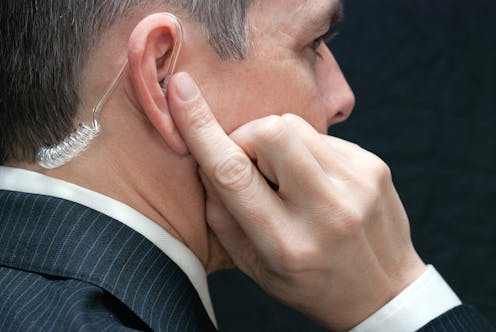If you want to know how to stop school shootings, ask the Secret Service
- Written by Jeff Daniels, Professor of Counseling, West Virginia University

While President Donald Trump has not shied away from offering suggestions on how to prevent school shootings – including one controversial idea[1] to arm teachers – what often gets overlooked in the conversation is research on the subject that has already been done.
This research includes one major study[2] of school shootings conducted in part by the very agency charged with protecting the president of the United States himself - the U.S. Secret Service.
Has this research been ignored or just forgotten? I raise the question as one who has studied averted school shootings and the news coverage that followed.
Two months after the Columbine tragedy in 1999, experts from the U.S. Department of Education and the U.S. Secret Service collaborated to study the “school shooter” phenomenon. They published the study[3] on their findings in 2002. The study focused on examining the thinking, planning and other behaviors of students who carried out school attacks. Particular attention was given to identifying pre-attack behaviors and communications that might be detectable – or “knowable” – and could help prevent future attacks.
The team studied 37 school shootings involving 41 attackers that took place from December 1974 through May 2000. Data included investigative, school, court and mental health records. In addition, 10 school shooters were interviewed to gain their perspectives from “conceptualization to execution” of the attacks. A series of findings emerged. In light of the Florida school shooting massacre and the fact that the alleged shooter drew a lot of attention[4] prior to carrying out the shooting, those findings bear repeating here.
“Incidents of targeted violence at school rarely were sudden, impulsive acts.” Most attackers progressed through a process that started with an idea, to a plan, to accessing weapons and ending with the attack. If noticed, this process may be interrupted at any time before the attack.
“Prior to most incidents, other people knew about the attacker’s idea and/or plan to attack.” The implication is that schools must develop a culture that promotes student sharing of concerns about others. In studying schools that averted a shooting, I and other researchers found[5] that a key factor was establishing trusting relationships with students. We also found that the notion of “snitching” needed to be reframed to being helpful. Unfortunately, it seems that in the case of the Parkland shooting, multiple people did come forward with concerns. The alleged shooter was on several different radars, but unless he was posing an imminent danger to himself or others, he couldn’t be jailed or forced to receive psychological services. It therefore becomes an issue of individual versus collective rights. Unless we are ready as a society to lock people up for disturbing communications, there will be some individuals who will fall through the proverbial cracks.
Along similar lines, most attackers “engaged in some behavior prior to the incident that caused others concern or indicated a need for help.” Some of these behaviors included talking about bringing a gun to school, or warning friends to avoid a certain area of the school on a given day. The Parkland shooter had a history of violent and aggressive behavior, including Instagram posts about becoming a “professional school shooter[6].”
While most attackers – 96 percent – were male, the report found that there “is no accurate or useful ‘profile’ of students who engaged in targeted school violence.” Three-quarters of the attackers were white; one-quarter of the attackers came from other racial and ethnic backgrounds, including African-American (12 percent), Hispanic (5 percent), Native Alaskan (2 percent), Native American (2 percent) and Asian (2 percent). Most came from intact families, were doing well in school and were not loners, according to the report.
“Most attackers had difficulty coping with significant losses or personal failures. Moreover, many had considered or attempted suicide.” Knowing the students and what they are dealing with in their lives, such as parental divorce, ending of a relationship or other failures is important for getting help in a timely manner. The Parkland shooter’s adoptive mother died of pneumonia just three months prior to his deadly attack[7]. And at age 5, he also witnessed his father die[8] of a heart attack.
“Many attackers felt bullied, persecuted or injured by others prior to the attack.” Almost two-thirds reported being targeted by others prior to the attack, with some claiming to have withstood severe bullying for a long time. There is evidence that Nikolas Cruz was often mocked for his odd behavior.[9]
Following the publication of the Secret Service study on school shootings, my research on averted school shootings[10] found that schools that prevented a shooting had done some of the things recommended by the Secret Service.
The case in Florida shows that many of these recommendations were followed and people spoke up when they saw something wrong. The issue is whether authorities need more power to intervene once they have been made aware of a potential threat, or whether they just need to do a better job with the power they already have.
References
- ^ one controversial idea (www.cbsnews.com)
- ^ one major study (www.secretservice.gov)
- ^ the study (www.secretservice.gov)
- ^ drew a lot of attention (www.rollingstone.com)
- ^ found (scholar.google.com)
- ^ professional school shooter (www.cnn.com)
- ^ deadly attack (nypost.com)
- ^ witnessed his father die (nypost.com)
- ^ odd behavior. (www.miamiherald.com)
- ^ my research on averted school shootings (journals.sagepub.com)
Authors: Jeff Daniels, Professor of Counseling, West Virginia University

